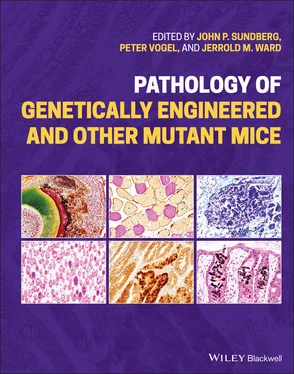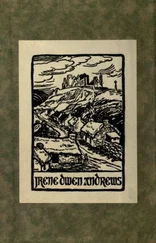Pathology of Genetically Engineered and Other Mutant Mice
Здесь есть возможность читать онлайн «Pathology of Genetically Engineered and Other Mutant Mice» — ознакомительный отрывок электронной книги совершенно бесплатно, а после прочтения отрывка купить полную версию. В некоторых случаях можно слушать аудио, скачать через торрент в формате fb2 и присутствует краткое содержание. Жанр: unrecognised, на английском языке. Описание произведения, (предисловие) а так же отзывы посетителей доступны на портале библиотеки ЛибКат.
- Название:Pathology of Genetically Engineered and Other Mutant Mice
- Автор:
- Жанр:
- Год:неизвестен
- ISBN:нет данных
- Рейтинг книги:3 / 5. Голосов: 1
-
Избранное:Добавить в избранное
- Отзывы:
-
Ваша оценка:
- 60
- 1
- 2
- 3
- 4
- 5
Pathology of Genetically Engineered and Other Mutant Mice: краткое содержание, описание и аннотация
Предлагаем к чтению аннотацию, описание, краткое содержание или предисловие (зависит от того, что написал сам автор книги «Pathology of Genetically Engineered and Other Mutant Mice»). Если вы не нашли необходимую информацию о книге — напишите в комментариях, мы постараемся отыскать её.
An updated and comprehensive reference to pathology in every organ system in genetically modified mice Pathology of Genetically Engineered and Other Mutant Mice
Pathology of Genetically Engineered and Other Mutant Mice
Pathology of Genetically Engineered and Other Mutant Mice — читать онлайн ознакомительный отрывок
Ниже представлен текст книги, разбитый по страницам. Система сохранения места последней прочитанной страницы, позволяет с удобством читать онлайн бесплатно книгу «Pathology of Genetically Engineered and Other Mutant Mice», без необходимости каждый раз заново искать на чём Вы остановились. Поставьте закладку, и сможете в любой момент перейти на страницу, на которой закончили чтение.
Интервал:
Закладка:
7 7 Sass, B. and Montali, R.J. (1980). Spontaneous fibro‐osseous lesions in aging female mice. Lab. Anim. Sci. 30 (5): 907–909.
8 8 Albassam, M.A., Wojcinski, Z.W., Barsoum, N.J., and Smith, G.S. (1991). Spontaneous fibro‐osseous proliferative lesions in the sternums and femurs of B6C3F1 mice. Vet. Pathol. 28 (5): 381–388.
9 9 Berndt, A., Ackert‐Bicknell, C., Silva, K.A. et al. (2016). Genetic determinants of fibro‐osseous lesions in aged inbred mice. Exp. Mol. Pathol. 100 (1): 92–100.
10 10 Rodewald, H.R. (2008). Thymus organogenesis. Annu. Rev. Immunol. 26: 355–388.
11 11 de Vries, M.J. and Hijmans, W. (1967). Pathological changes of thymic epithelial cells and autoimmune disease in NZB, NZW and (NZB x NZW)F1 mice. Immunology 12 (2): 179–196.
12 12 Li, L., Hsu, H.C., Grizzle, W.E. et al. (2003). Cellular mechanism of thymic involution. Scand. J. Immunol. 57 (5): 410–422.
13 13 Xu, P.X., Adams, J., Peters, H. et al. (1999). Eya1‐deficient mice lack ears and kidneys and show abnormal apoptosis of organ primordia. Nat. Genet. 23 (1): 113–117.
14 14 Xu, P.X., Zheng, W., Laclef, C. et al. (2002). Eya1 is required for the morphogenesis of mammalian thymus, parathyroid and thyroid. Development 129 (13): 3033–3044.
15 15 Nehls, M., Kyewski, B., Messerle, M. et al. (1996). Two genetically separable steps in the differentiation of thymic epithelium. Science 272 (5263): 886–889.
16 16 Manley, N.R. and Capecchi, M.R. (1998). Hox group 3 paralogs regulate the development and migration of the thymus, thyroid, and parathyroid glands. Dev. Biol. 195 (1): 1–15.
17 17 Dietrich, S. and Gruss, P. (1995). undulated phenotypes suggest a role of Pax‐1 for the development of vertebral and extravertebral structures. Dev. Biol. 167 (2): 529–548.
18 18 Conway, S.J., Henderson, D.J., and Copp, A.J. (1997). Pax3 is required for cardiac neural crest migration in the mouse: evidence from the splotch (Sp2H) mutant. Development 124 (2): 505–514.
19 19 Peters, H., Neubuser, A., Kratochwil, K., and Balling, R. (1998). Pax9‐deficient mice lack pharyngeal pouch derivatives and teeth and exhibit craniofacial and limb abnormalities. Genes Dev. 12 (17): 2735–2747.
20 20 Laclef, C., Souil, E., Demignon, J., and Maire, P. (2003). Thymus, kidney and craniofacial abnormalities in Six 1 deficient mice. Mech. Dev. 120 (6): 669–679.
21 21 Jerome, L.A. and Papaioannou, V.E. (2001). DiGeorge syndrome phenotype in mice mutant for the T‐box gene, Tbx1. Nat. Genet. 27 (3): 286–291.
22 22 Custer, R.P., Bosma, G.C., and Bosma, M.J. (1985). Severe combined immunodeficiency (SCID) in the mouse. Pathology, reconstitution, neoplasms. Am. J. Pathol. 120 (3): 464–477.
23 23 Mombaerts, P., Iacomini, J., Johnson, R.S. et al. (1992). RAG‐1‐deficient mice have no mature B and T lymphocytes. Cell 68 (5): 869–877.
24 24 Shinkai, Y., Rathbun, G., Lam, K.P. et al. (1992). RAG‐2‐deficient mice lack mature lymphocytes owing to inability to initiate V(D). J. Rearrangement. Cell 68 (5): 855–867.
25 25 DiSanto, J.P., Muller, W., Guy‐Grand, D. et al. (1995). Lymphoid development in mice with a targeted deletion of the interleukin 2 receptor gamma chain. Proc. Natl. Acad. Sci. U.S.A. 92 (2): 377–381.
26 26 Cao, X., Shores, E.W., Hu‐Li, J. et al. (1995). Defective lymphoid development in mice lacking expression of the common cytokine receptor gamma chain. Immunity 2 (3): 223–238.
27 27 Pearse, G. (2006). Histopathology of the thymus. Toxicol. Pathol. 34 (5): 515–547.
28 28 Burnet, F.M. and Holmes, M.C. (1964). Thymic changes in the mouse strain Nzb in relation to the auto‐immune state. J. Pathol. Bacteriol. 88: 229–241.
29 29 Van den Broeck, W., Derore, A., and Simoens, P. (2006). Anatomy and nomenclature of murine lymph nodes: descriptive study and nomenclatory standardization in BALB/cAnNCrl mice. J. Immunol. Methods 312 (1–2): 12–19.
30 30 van de Pavert, S.A. and Mebius, R.E. (2010). New insights into the development of lymphoid tissues. Nat. Rev. Immunol. 10 (9): 664–674.
31 31 Onder, L. and Ludewig, B. (2018). A fresh view on lymph node organogenesis. Trends Immunol. 39 (10): 775–787.
32 32 Colbeck, E.J., Ager, A., Gallimore, A., and Jones, G.W. (2017). Tertiary lymphoid structures in cancer: drivers of antitumor immunity, immunosuppression, or bystander sentinels in disease? Front. Immunol. 8: 1830.
33 33 Buckley, C.D., Barone, F., Nayar, S. et al. (2015). Stromal cells in chronic inflammation and tertiary lymphoid organ formation. Annu. Rev. Immunol. 33: 715–745.
34 34 Bellomo, A., Gentek, R., Bajenoff, M., and Baratin, M. (2018). Lymph node macrophages: scavengers, immune sentinels and trophic effectors. Cell. Immunol. 330: 168–174.
35 35 Pasparakis, M., Alexopoulou, L., Episkopou, V., and Kollias, G. (1996). Immune and inflammatory responses in TNF alpha‐deficient mice: a critical requirement for TNF alpha in the formation of primary B cell follicles, follicular dendritic cell networks and germinal centers, and in the maturation of the humoral immune response. J. Exp. Med. 184 (4): 1397–1411.
36 36 De Togni, P., Goellner, J., Ruddle, N.H. et al. (1994). Abnormal development of peripheral lymphoid organs in mice deficient in lymphotoxin. Science 264 (5159): 703–707.
37 37 Banks, T.A., Rouse, B.T., Kerley, M.K. et al. (1995). Lymphotoxin‐alpha‐deficient mice. Effects on secondary lymphoid organ development and humoral immune responsiveness. J. Immunol. 155 (4): 1685–1693.
38 38 Koni, P.A., Sacca, R., Lawton, P. et al. (1997). Distinct roles in lymphoid organogenesis for lymphotoxins alpha and beta revealed in lymphotoxin beta‐deficient mice. Immunity 6 (4): 491–500.
39 39 Alimzhanov, M.B., Kuprash, D.V., Kosco‐Vilbois, M.H. et al. (1997). Abnormal development of secondary lymphoid tissues in lymphotoxin beta‐deficient mice. Proc. Natl. Acad. Sci. U.S.A. 94 (17): 9302–9307.
40 40 Futterer, A., Mink, K., Luz, A. et al. (1998). The lymphotoxin beta receptor controls organogenesis and affinity maturation in peripheral lymphoid tissues. Immunity 9 (1): 59–70.
41 41 Kong, Y.Y., Yoshida, H., Sarosi, I. et al. (1999). OPGL is a key regulator of osteoclastogenesis, lymphocyte development and lymph‐node organogenesis. Nature 397 (6717): 315–323.
42 42 Dougall, W.C., Glaccum, M., Charrier, K. et al. (1999). RANK is essential for osteoclast and lymph node development. Genes Dev. 13 (18): 2412–2424.
43 43 Weih, F. and Caamano, J. (2003). Regulation of secondary lymphoid organ development by the nuclear factor‐kappaB signal transduction pathway. Immunol. Rev. 195: 91–105.
44 44 Miyawaki, S., Nakamura, Y., Suzuka, H. et al. (1994). A new mutation, aly, that induces a generalized lack of lymph nodes accompanied by immunodeficiency in mice. Eur. J. Immunol. 24 (2): 429–434.
45 45 Fukuyama, S., Hiroi, T., Yokota, Y. et al. (2002). Initiation of NALT organogenesis is independent of the IL‐7R, LTbetaR, and NIK signaling pathways but requires the Id2 gene and CD3(−)CD4(+)CD45(+) cells. Immunity 17 (1): 31–40.
46 46 Yokota, Y., Mansouri, A., Mori, S. et al. (1999). Development of peripheral lymphoid organs and natural killer cells depends on the helix‐loop‐helix inhibitor Id2. Nature 397 (6721): 702–706.
47 47 Sun, Z., Unutmaz, D., Zou, Y.R. et al. (2000). Requirement for RORgamma in thymocyte survival and lymphoid organ development. Science 288 (5475): 2369–2373.
48 48 Tachibana, M., Tenno, M., Tezuka, C. et al. (2011). Runx1/Cbfbeta2 complexes are required for lymphoid tissue inducer cell differentiation at two developmental stages. J. Immunol. 186 (3): 1450–1457.
49 49 Nagatake, T., Fukuyama, S., Sato, S. et al. (2015). Central role of core binding factor beta2 in mucosa‐associated lymphoid tissue organogenesis in mouse. PLoS One 10 (5): e0127460.
Читать дальшеИнтервал:
Закладка:
Похожие книги на «Pathology of Genetically Engineered and Other Mutant Mice»
Представляем Вашему вниманию похожие книги на «Pathology of Genetically Engineered and Other Mutant Mice» списком для выбора. Мы отобрали схожую по названию и смыслу литературу в надежде предоставить читателям больше вариантов отыскать новые, интересные, ещё непрочитанные произведения.
Обсуждение, отзывы о книге «Pathology of Genetically Engineered and Other Mutant Mice» и просто собственные мнения читателей. Оставьте ваши комментарии, напишите, что Вы думаете о произведении, его смысле или главных героях. Укажите что конкретно понравилось, а что нет, и почему Вы так считаете.












